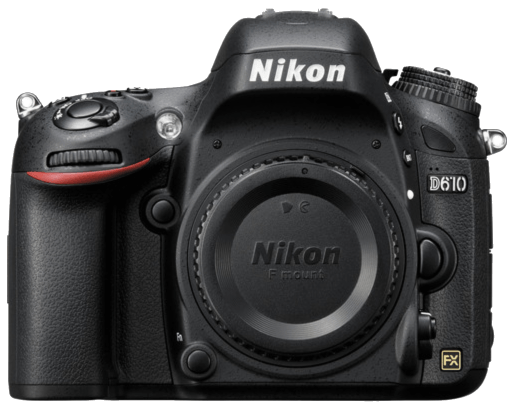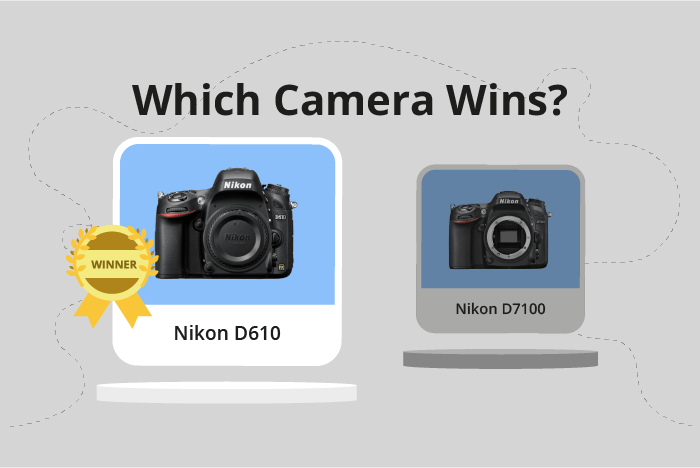Nikon D610 vs D7100 Comparison
Nikon D610

Nikon D7100

The Nikon D610 narrowly edges out the Nikon D7100 with a score of 66/100 compared to 65/100. Both cameras are DSLRs released in 2013 and share some common specifications such as camera type, release year, and similar dimensions. The D610 has a slightly larger size (141 x 113 x 82mm) and is heavier at 850g, compared to the D7100’s smaller size (136 x 107 x 76mm) and lighter weight of 765g.
The D610 has a higher launch price of $1999, which could be justified by its marginally better performance. On the other hand, the D7100 is more affordable with a launch price of $1200, making it an attractive option for those on a budget.
Considering their close scores and specifications, the Nikon D610 takes the lead with a slightly better performance while the Nikon D7100 offers a more budget-friendly option without compromising too much on quality.
Nikon D610 vs D7100 Overview and Optics
The Nikon D610 outperforms the Nikon D7100 in optics with a score of 70/100, a 3-point lead over the D7100’s 67/100. Both cameras share common specifications, such as 24 megapixels, a shooting speed of 6, a CMOS sensor type, an Expeed 3 processor, and no image stabilization.
The D610’s superiority in optics is primarily due to its full-frame sensor size and higher DXOMARK score of 94, compared to the D7100’s APS-C sensor size and DXOMARK score of 83. With a full-frame sensor, the D610 captures more light and provides better image quality, especially in low-light conditions. The larger sensor size also allows for a shallower depth of field, making it ideal for professional portrait photography. Furthermore, the Nikon D610’s F FX lens mount offers compatibility with a wider range of lenses, providing more options for photographers.
On the other hand, the Nikon D7100 has a slight edge in megapixels, with 24.1 compared to the D610’s 24. This marginal difference, however, is not significant enough to impact image quality. The D7100’s F DX lens mount is designed for APS-C cameras, which may offer more affordable lens options.
In terms of optics, the Nikon D610 is the superior choice due to its full-frame sensor, higher DXOMARK score, and broader lens compatibility. The Nikon D7100, while slightly behind in optics performance, still offers competitive specifications and may be a more budget-friendly option for some photographers.
Nikon D610 vs D7100 Video Performance
When comparing the video capabilities of the Nikon D610 and Nikon D7100, both cameras tie with a video score of 57 out of 100. This indicates that their video performance is quite similar. In terms of common specifications, both cameras have a maximum video resolution of Full HD, with video dimensions of 1920 x 1080. Additionally, both cameras have a maximum video frame rate of 30fps and built-in time-lapse functionality.
The winning camera in this comparison cannot be determined as both cameras have the same score, meaning their video capabilities are on par with each other. However, there may be other factors or personal preferences that could make one camera more appealing than the other for specific users.
Despite the similar video scores, there may be some differences in video quality, features, or ease of use between the two cameras. These differences could potentially make one camera more suitable for certain types of videography or for users with specific needs. It is important to consider these factors when deciding between the Nikon D610 and Nikon D7100.
In conclusion, the Nikon D610 and Nikon D7100 have identical video scores, which means their video capabilities are quite similar. Both cameras offer Full HD resolution, 1920 x 1080 video dimensions, a maximum frame rate of 30fps, and built-in time-lapse functionality. Users should consider other factors and personal preferences when choosing between these two cameras for their video needs.
Nikon D610 vs D7100 Features and Benefits
The Nikon D7100 comes out on top with a feature score of 59/100, while the Nikon D610 trails slightly behind with a score of 57/100. Both cameras share several similarities in their specifications, including a 3.2-inch screen size, the absence of a touchscreen, flip screen, GPS, and Bluetooth. Additionally, both cameras have WIFI capabilities.
The winning camera, the Nikon D7100, excels in screen resolution, boasting 1,228,800 dots, which is considerably higher than the Nikon D610’s 921,000 dots. This higher resolution provides a clearer and sharper image display, enhancing the user’s experience when reviewing images on the camera.
Despite its lower overall feature score, the Nikon D610 does have some advantages. However, these advantages are not reflected in the provided specifications, as both cameras seem to have identical features in this comparison.
Considering these points, the Nikon D7100 proves to be a better camera in terms of features due to its higher screen resolution. This increased resolution offers a more enjoyable experience when reviewing images on the camera’s screen. The Nikon D610, while not the winner in this comparison, still provides a solid set of features, making it a viable option for those looking for a reliable camera. Ultimately, the choice between these two cameras will depend on the individual photographer’s needs and preferences.
Nikon D610 vs D7100 Storage and Battery
The Nikon D7100 outperforms the Nikon D610 in storage and battery with a score of 76/100, compared to the D610’s score of 71/100. Both cameras share common specifications, including two memory card slots, compatibility with SD/SDHC/SDXC cards, the use of the EN-EL15 battery type, and the absence of USB charging.
The D7100’s advantage lies in its longer battery life, providing 950 shots per charge, while the D610 offers 900 shots. This difference allows the D7100 users to capture more images without needing to replace or recharge the battery.
On the other hand, the D610 does not have any specific advantages over the D7100 in terms of storage and battery. However, this does not mean the D610 is an inferior camera, as it still provides satisfactory battery life and storage options for most users.
Taking the storage and battery aspects into account, the Nikon D7100 has a slight edge over the Nikon D610 due to its extended battery life. Nevertheless, both cameras offer reliable performance and cater to various photography needs.
Nikon D610 vs D7100 – Our Verdict
Are you still undecided about which camera is right for you? Have a look at these popular comparisons that feature the Nikon D610 or the Nikon D7100:

